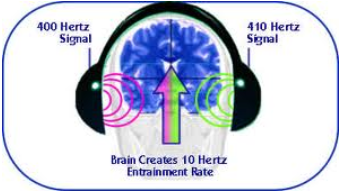Brainwave Entrainment, important for You 2
Brainwave Entrainment – This is using stimuli (such as sound, light, or EM fields) to influence the rate of our brainwaves, which in the process affects our mental state.
Our brain plays “monkey see/monkey do” with stimuli in the proximity. If you have lights flashing at 4 cycles a second, our brain will begin to mimic that with its own brainwaves. When our brainwaves are at a certain frequency, our body will do whatever it normally would do — we normally produce brainwaves of 4 cycles a second when we’re sleeping – so pulsating light at this rate would put a person to sleep.
Say you want to do this with sound instead of pulsating light – since most brainwave entrainment frequencies are below 30 HZ, and are often below human hearing range, you (usually) can’t just generate the tones using a wave generator. There are two methods that are typically used to generate these ultra-low tones in a way that humans can perceive them and feel their effects.
1. Binaural Beats.

The concept of “binaural beats”.
For a long time, we’ve been aware that certain frequencies are associated with certain states of mind. For example, the alpha frequency of 8 to 12Hz is present when individuals are in a relaxed super-learning and positive-thinking mode. This mind frequency is usually obtained through meditation, and can be verified through an electroencephalograph (EEG) reading.
We can’t however simply listen to such frequencies in an attempt to adopt that frame of mind. The ears can only typically hear between 20 and 20,000Hz.
If we could manage to replicate the lower frequencies somehow, we could play these to the mind and thereby recreate these effects on demand.
In 1939 the German experimenter H.W. Dove discovered that by playing two coherent sounds of similar frequencies into each ear, a third “binaural beat” is produced.
Binaural Beats – Using a computer or synthesizer (and a good pair of stereo headphones), generate two tones, one in the left ear, one in the right – your brain imagines it hears a third tone equal to the difference between the two tones.
(For instance, if you had a 400 HZ tone in one ear, and a 410 HZ tone in the other, you would perceive a third tone of 10 HZ.)
And this would have the same effects that a pulsating light at 10 cycles per second would. In order for this to work, the two tones need to be below 1000 HZ.
When using an MP3 with Binaural beats a stereo headphone is required.
2. Isochronic Tones.

Isochronic tones – While a tone at 4 HZ would be too low to hear by itself, if you can generate four beeps per second, this will have the same effect as 4 Hz binaural beats.
So Isochronic tones can also be used for brainwave entrainment.
And stereo headphones are not required.
3. Which one to use?
As far as which of these two methods are better – binaural beats probably work better for brainwave entrainment, but the second method will work from speakers – headphones aren’t required. That can come in handy – especially when you want to experiment with brainwave entrainment while sleeping or meditating – ever tried falling asleep wearing headphones? I have a cordless pair, and even with those, it’s not that comfortable.
I like to use a Bluetooth speaker next to my bed and then play whatever night MP3 I choose for the night or even a complete playlist. There are many sleep better and sleep programming (with subliminal messages) recordings available.
4. Brainwave frequency groups.
Since a long time scientists know that in different situations and ages the brain frequency is different. The known brain frequency groups are:
1. Alpha range : 8 – 13 Hz (so 8 – 13 beats per second). In general the Alpha state has a relaxing influence on the body. An Alpha state is often reached during meditation.
2. Beta range 13 – 27 Hz, this is the normal state of adults during the day. It I associated with thinking, worrying, problem solving, outer awareness and fear.
3. Delta range 0.1 – 3 Hz, associated with deep dreamless sleep.
4. Theta range 3 – 8 Hz, associated with deep relaxation, deep mediation, creativity, memory and lucid dreaming.
5. Gamma range 30 – 60 Hz, this range is less known about and there is some disagreement about the definition of the Gamma range. It is better to see what the influence is of the individual frequencies.
Note the different frequency ranges as described above are not the only definitions. Some people have their own definition. More important are the individual frequencies within a range and their influence on the body, brain and cells.
See the Digital Store for products using Brainwave Entrainment go to Imanawa Digital Store
Table of Contents
Number of items in cart: 0
- Your cart is empty.
- Subtotal: $0.00
- Estimated Tax: $0.00
- Total: $0.00
- Checkout
- Sleep well with the Solfeggio Night Suite.
- Title: Unveiling the Potential of Grabovoi Number Sequences:
- Subliminal messaging a powerful tool 4 you
- Manawa, one of the very deep 7 principles.
- Verwijs vrienden om lid te worden van Pi Netwerk
- Hawaiian friends
- Brainwave Frequencies
- Sound Healing
- Google Pay
- Solfeggio Tones, Why Important?
- Alpha frequency
- bank account
- Binaural beats
- brain power
- Brainwave entrainment
- brainwave frequencies
- crypto coin
- crypto mining
- deep sleep
- Google Pay
- Hawaii
- Inner power
- Isochronic tones
- manawa
- money
- power nap
- self-development
- sleep
- sleep problems
- solfeggio
- solfeggio tones
- sound healing
- Subliminal
- subliminal messages
- Theta frequency
- wealth
